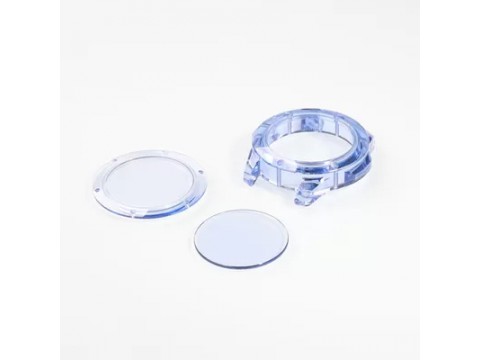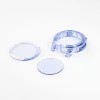Product Description
Blue Color Sapphire Watch Case For Luxury Brand
Czochralski method, or CZ method for short. First heating the raw material to the melting point and then melting to form a melting soup, and then using a single crystal seed to contact the surface of the melting soup, in the crystal seed and the solid liquid interface of the melted soup due to the temperature difference and formed too cold. So the melted soup began to solidify on the surface of the seed and grow a single crystal with the same crystal structure as the seed. The seed is also pulled up at a very slow speed, and accompanied by a certain speed of rotation, with the upward pull of the seed, the melt soup gradually solidified on the liquid solid interface of the seed, and then formed a axis of symmetrical single crystal ingot.
FATURES
1. High transmittance
2. High mechanical strength
3. High temperature resistance
4. Scratch resistance
5. Abrasion resistance
6. Customized shape
7. Optional color
| Property | Specifications |
| Thickness | 0.5-200mm |
| Size Tolerance | ±0.01 |
| Edge Finish | Ground and beveled |
| Surface Quality | 40-20 scratch-dig |
| Surface Flatness | λ/4@633nm |
| Parallelism | ≤3 arc min(≤0.9mrad) |
| Clear Aperture | >80% of central diameter |
| Hardness(Knoop) | 1370 kg/mm2 |
| Young's modulus | 3.4*1011N/m2 |
| Thermal Limit | 22W/m/K |
| Thermal expansion coefficient |
8.4*10-6/K |



These excellent optical, mechanical, thermal, chemical and electrical properties determine its important position and role in the military and civilian fields.
(1) Chemical stability: Sapphire has a high degree of chemical stability and will not be corroded during most chemical reactions.
(2) Mechanical properties: Due to its high hardness and high strength, sapphire single crystal can maintain high strength, wear resistance and high stability in different environments ranging from ultra-low temperature to 1500 ℃ high temperature. At the same time, it is the oxide crystal material with the highest hardness currently known, second only to diamond up to 9 on the Mohs scale.
(3) Optical transmittance: The penetration wavelength range of sapphire single crystal material is 0.19nm-5.5nm, coupled with its excellent chemical stability, abrasion resistance, high hardness and high temperature resistance, make the windows made of sapphire and Sensor optical parts are widely used in high vacuum systems, high temperature furnaces and other harsh environments.
(4) Thermodynamic properties: The melting point of about 2050°C, coupled with superior chemical, mechanical and optical properties, make sapphire crystals widely used in many harsh processing environments.
(5) Wear resistance: Because of its high hardness and transparency, sapphire crystals are often used to make wear-resistant windows or other precision mechanical parts.
(6) Dielectric properties: dielectric insulation and constant dielectric constant.
(7) Sapphire also has high tensile strength, erosion resistance, thermal conductivity, and remarkable thermal shock resistance.






